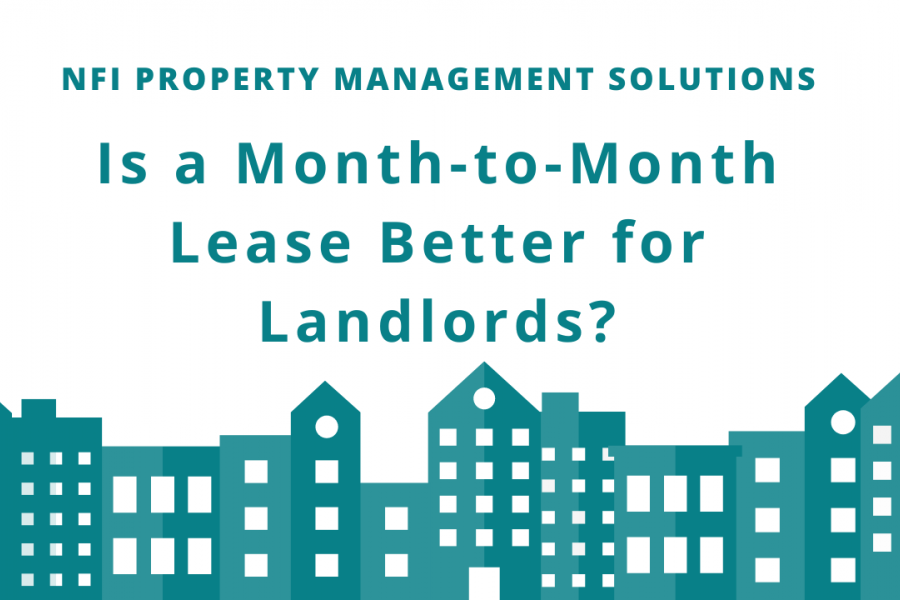
Most landlords opt to find long-term tenants for their rentals. Long-term tenancies give landlords stability and a sense of security. After all, longer leases give you peace of mind because your property will be occupied for several months or even years.
However, month-to-month leases can be very beneficial to landlords depending on their investment goals and needs.
That’s why the expert team at NFI Property Management Solutions has written this guide to help you decide whether a short-term lease agreement is right for you. Keep reading to learn the pros and cons of a month-to-month lease!
Understanding Month-to-Month Leases
Month-to-month leases are short-term rental agreements that give a renter the right to live in a property for a month. They’re typically used as an extension of an existing lease. For example, landlords can agree to a month-to-month lease if tenants want to stay on their property after their original lease has come to an end.
This kind of lease typically renews automatically until either party decides to break it. If you want to terminate a short-term lease early, you’ll usually be required to give a minimum of 15 to 30-day notice of non-renewal.

This is enough time for renters to find a new place to live and for landlords to get their property ready for new tenants.
Month-to-month rental agreements are also great for rentals in vacation spots or for landlords wanting to offer furnished rentals. Tenants looking to rent these types of properties only plan to stay for the short term, so you’re more likely to fill a furnished rental quickly on a short lease.
Pros and Cons of a Month-to-Month Lease
Month-to-month leases have many advantages over long-term leases. But they also have some downsides. Here’s what to keep in mind to determine if a short-term rental agreement is right for you:
Benefits of Month-to-Month Leases
Higher Rent Prices
Month-to-month leases have the potential to make more money as they can be rented at a higher price than long-term rentals. This is because short-term renters are willing to spend more on rent for a unit that is in good condition and has everything they need during their stay.
Additionally, landlords get to charge a higher rent for short-term rentals as a protective measure. Renting your home on a month-to-month basis can be riskier. Charging a premium rate every month can help you cover any unexpected costs, such as repairs or additional maintenance.
More Flexibility
With a month-to-month lease, landlords have the flexibility to end the rental agreement at any time. For instance, if you want to occupy your property or find tenants that are a better fit, you can simply give renters a nonrenewal notice. This way, you’ll have more control over who occupies your property!

Additionally, with short-term leases, you can tweak the conditions and clauses of the rental agreement at any time. If you notice an error or want to add a new clause to your current lease, you’ll only have to wait a month to sign a new contract.
Avoid Holdover Tenants
Month-to-month leases make it easier for you to get rid of problematic tenants. Plus, they can help you avoid having tenants overstay their welcome. You can end the rental agreement at any time, and having a signed lease in place can help you remove holdover tenants quickly.
Fill Your Vacancies Quickly
When you have a month-to-month lease, tenants will let you know they won’t be renewing the lease up to 30 days in advance. This gives you enough time to start looking for a replacement tenant.
With effective advertising, you can welcome new tenants into your property shortly after the former renters vacate it. This can highly reduce the risks associated with leaving your rental vacant for too long.
Find Quality Tenants
When you rent out your home on a month-to-month basis, it’ll be easier to find great tenants. A short-term lease can be a trial period to help you determine whether a new renter is a good fit for your rental.

The ability to end the lease at any time can help you weed out problematic renters and ensure only quality tenants occupy your property.
Cons of a Month-to-Month Lease
Unstable Source of Income
With month-to-month leases, you don’t have the security of knowing your property will be rented for several months on end. Because tenants can end the rental agreement at any time, your passive source of income may be inconsistent.
Additional Costs
Short-term tenancies come with additional costs you need to consider. If your renters don’t stay for more than a couple of months, you’ll have to invest a lot of money in maintenance to keep the property in good shape and find new tenants.
Uncertainty
With a month-to-month lease, you are always 30 days away from having an empty unit. Renters can choose not to renew the lease with 30 days' notice. So, you won’t have the security of knowing that your rental will be occupied for the long term.
Burnout
Managing a rental property by yourself can be exhausting. Tasks like advertising your rental and screening prospective tenants are extremely tiring and time-consuming. With a short-term rental, you’ll find yourself doing these tasks very often.

Plus, you’ll have to do them in a short amount of time to avoid vacancies. This can create a lot of stress for you, especially as you get closer to the end date of the lease.
How to Create a Month-to-Month Lease Agreement
When you rent your home on a month-to-month basis, you need to create a solid lease agreement to ensure you and your property are protected.
A lease or rental agreement should include essential information such as the price of rent and the due date for payments, tenant obligations, and terms of the tenancy. You should also include key clauses, such as:
- Subletting policies
- Renewal terms
- Security deposit requirements
- Insurance requirements
- Penalties for late rent
- Pet policies
If you need expert help drafting a month-to-month lease, consider hiring a seasoned property management company. These professionals can help you draft a solid lease agreement. Plus, they can offer guidance in legal cases such as court disputes and evictions.
Bottom Line
A month-to-month lease can be highly beneficial for landlords. This type of lease agreement has many advantages, including a higher profit potential and more flexible terms. But short-term leases also have some drawbacks, such as uncertainty and the risk of temporarily losing your source of income.
If you want to know how a month-to-month lease can benefit your Florida rental, contact NFI Property Management Solutions! With over 30 years of experience in the tri-county area real estate, we know what it takes for a rental business to succeed!